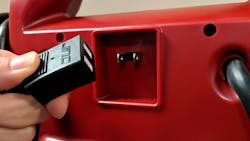Green light is on — Why am I charging?
We briefly touched on this topic in last month’s feature article, but the number of calls, emails, blog posts, and Clore stories related to it definitely warrants addressing it on a stand-alone basis. Many customers are confused when we call for charging their unit when they see a green light (or FULL) when they check the battery’s charge status or state of charge (SoC). So, let’s dig into that.
Here’s how we usually get this question/comment:
- “Your carton said to charge the unit for 24 hours when first opened, but the unit shows a green light?”
- “I got your recharge alert, but my unit shows fully charged.”
- “I love my JNC660/ES5000. I’ve had it three years and it has never even needed a charge.”
There are many other variations, but the three above examples essentially capture the general idea. It’s true that our units typically hold a charge for a long time. That’s a really good thing. But, it shouldn’t stop you from regularly charging the unit, which is the most beneficial thing that you can do for your jump starter’s health. So, we’ll tackle each of these scenarios individually below.
1. Out of the box – you say to charge it, but it says it’s full?
Of course, this is a seeming contradiction, and we couldn’t blame anyone for wondering what to do in this situation. First, the reason why we added this to the package and the manual is that we have no way to know how long it will take for a specific unit to reach the final purchaser. As a result, we instruct all purchasers to charge their unit upon initial purchase. We’re doing it mostly for those purchasers where the unit needs a charge when first purchased (shows amber or CHARGE).
Yet, there’s also value for someone whose brand-new unit shows green. There can be a fair amount of SoC difference between “fully charged” and “charged enough to yield a green light.” So, charging the unit upon initial purchase, even if the light is green, yields benefits for the unit’s battery and its overall longevity.
2. Got my quarterly recharge alert, but my unit is already green?
This is mostly a variation of the above example, yet it is different. The assumption here is that you have likely used the unit at some point and still find yourself in this situation. What to do? Like the above example, there’s a difference between being charged enough to light the green light and being fully charged. In this difference, there’s a world of opportunity for sulfation to creep into your battery and speed its inexorable march toward the end.
What is sulfation and why is it a problem?
Sulfation, without going full chemistry lesson on you, is the natural process in a lead acid battery by which particles form on the plates over time, limiting the battery’s ability to fully recover to full strength when it is charged. The best way to fend off sulfation is to keep your battery/jump starter fully charged as much as possible. This is why we say, “Charge early, charge often.” Conversely, the best way to speed a lead acid battery’s demise is to let it sit in a discharged state for a long period of time.
So, you might say, “If it’s green, the jump starter isn’t really in a discharged state. What gives?” Great point. It’s true that a unit showing green is “mostly” charged and therefore not deeply discharged. The best analogy we can offer here is that your battery is like a swimming pool and regular charging is like a pool cover. It keeps a lot of unwanted junk from getting in and ruining the pool/battery. A green, but not truly fully charged, unit is like having one corner of the pool cover out of place. You’re mostly good, but bad stuff can still creep in. So, charge it regularly (every 90 days), whether it seems to need it or not. Your unit will reward you with better performance and longer useful life.
3. I’ve had my unit for years; it seems to never need a charge.
Again, a variation on the two examples above. We love that customers appreciate the way our units hold a charge, but for the reasons stated above, we strongly recommend charging the jump starter every 90 days.
Some users recognize that the jump starter is getting charge back from the vehicle that was just jump-started and feel this may be a sufficient means of recharging after use. We strongly advise against this practice. We suggest disconnecting your jump starter from the running vehicle as quickly as possible after the successful jump start has taken place. This is because the vehicle’s alternator output (current) is typically 20-30 times higher than the current of your jump starter’s internal or external charger. It’s simply too much power and extended exposure to the alternator’s output can be damaging to your jump starter’s battery. So, let the included charger (whether built-in or external) do the charging – as we also like to say, “Low and slow is the way to go.”
We hope this clears up any confusion that might exist or helps to resolve what could be interpreted as conflicting information from us. Our goal is to always provide you with clear details and directions that help you get the most from the products you invest in from us.
Information provided by Clore Automotive
About the Author

Jim O' Hara
Clore Automotive
Jim O'Hara has over 15 years experience in the Tool and Equipment industry, including 10+ years at Clore Automotive. At Clore, he heads up the marketing team and is directly involved in the development of new products and enhancements of existing products.
